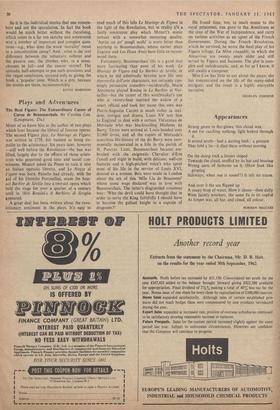Plays and Adventures The Real Figaro: The Extraordinary Career of
Caron de Beauniarehais. By Cynthia Cox. (Longrnans, 25s.) MOST of us know him as the author of two plays which later became the libretti of famous operas. The second Figaro play, Le Manage de Figaro, was written in 1778, but banned as being im- polite to the aristocracy. Six years later, however —still well before the Revolution—the ban was lifted, largely due to the efforts of those aristo- crats who possessed good taste and social con- sciences. Mozart asked da Ponte to turn it into an Italian operatic libretto, and Le Nozze di Figaro was born. Paisello had already, with the lid of his librettist Petrosellini, made the four- act Barbier de Seville into a two-act opera which held the stage for over a quarter of a century until in 1816 Rossini's 11 Barbiere di Siviglia appeared. A great deal has been written about the revo- lutionary sentiment in the plays. It's easy to read much of this info Le Manage de Figaro in the light of the Revolution, but in reality it's a fairly innocuous play which Mozart's music imbues with a somewhat menacing quality. `Aprite un po' quegli occhr is more bitter than anything in Beaumarchais, whose earlier plays Eugenie and Les Deux Amis have little to recom- mend therm Fortunately, Beaumarchais' life is a good deal more fascinating than most of his work Le Mariage de Figaro and Le Barbier de Seville, in which he did admittedly breathe new life into commedia dell'arte characters, are certainly cun- ningly persuasive comedies—incidentally, Marie Antoinette played Rosine in Le Barbier at Ver- sailles—but the career of this watchmaker's son who a: twenty-four married the widow of a court official and took her name (his own was Pierre-Augustin Caron) is much richer in inci- dent. intrigue and drama. Louis XV sent him to England to deal with a certain Thdveneau de Morande who was blackmailing Madame du Barry. Terms were arrived at. Louis handed over 32,000 livres, and all the copies of Morande's scurrilous life-history of the du Barry were cere- monially incinerated in a kiln in the parish of St. Pancras. Later, Beaumarchais became em- broiled with the enigmatic Chevalier d'Eon ('small and slight in build, with delicate, well-cut features and a high-pitched voice') who spent most of his life in the service of Louis XVI, dressed as a woman. Bets were made in London about the sex of this 'Mlle Lia de Beaumont' whom some wags declared was in love with Beaumarchais. The latter's disgruntled comment was: 'Who the devil could have thought that in order to serve the King faithfully I should have to become the gallant knight to a captain of dragoons?' He found time, too, to teach music to the royal princesses, run guns to the Americans at the time of the War of Independence, and carry on various activities as an agent of the French Government. During the French Revolution, which he survived, he wrote the final play of his Figaro trilogy, La Mere coupable, in which the Almavivas are twenty years older and still served by Figaro and Suzanne. The plot is com- plex and melodramatic, and, as far as 1 know, it still awaits a composer.
Miss Cox has little to say about the plays; she has concentrated on the life of the many-sided intriguer, and the result is a highly enjoyable narrative.
CHARLES OSBORNE






























 Previous page
Previous page